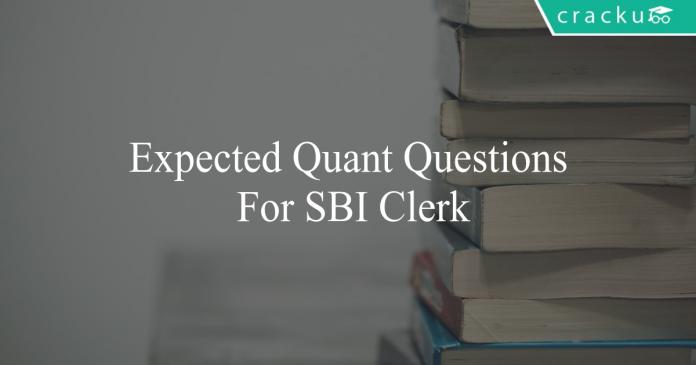Expected Quant Questions For SBI Clerk PDF
Download SBI Clerk Expected Quant Questions & Answers PDF for SBI Clerk Prelims and Mains exam. Very Important SBI Clerk Expected Quant questions with solutions.
Download Expected Quant Questions For SBI Clerk
790+ Mocks – Just Rs. 194. Use coupon: SBIDREAM70
Download SBI Clerk Puzzles Set-1 PDF
Question 1: In 8 years, Ramesh will be twice as old as Farheen was 8 years ago. If Ramesh is now 16 years older than Farheen, the present age of Farheen is :
a) 32
b) 40
c) 36
d) 44
e) 24
Question 2: A was thrice as old as B when C was 2 years old. A will be twice as old as B when C is 10 years old. How old will B be when the difference between the ages of A and B will be equal to the age of C?
a) 16 years
b) 22 years
c) 18 years
d) 24 years
e) 32 years
Question 3: Find the approximate value of $\Large\frac{169.87^{2}-13.94^{2}}{183.87}$ $\large+$ $\Large\frac{3211.96}{44.002}$
a) 224
b) 236
c) 239
d) 229
e) None of these
Download SBI Clerk Previous Papers PDF
Take a free mock test for SBI Clerk
Question 4: Find the approximate value of $17.33+142.895-76.795+235.008-4.779+38.102$
a) 321
b) 351
c) 281
d) 371
e) None of these
Question 5: The average marks of a class increased by $\large\frac{1}{3}$ when a student’s marks were wrongly entered as 64 instead of 46. The number of students in the class are
a) 54
b) 58
c) 63
d) 57
e) None of these
Question 6: The average age of students in a class is 12. If the average age of boys is 18 and the average age of girls is 14 and If the number of boys are 22, then find the total number of students in the class
a) 52
b) 55
c) 60
d) 58
e) None of these
Instructions
Select the correct option.
Question 7: Quantity 1:A number is increased by 85% and then it is decreased by 15% and result is approximately 357
Quantity 2:A number is increased by 82% and then it is decreased by 12% and the result is approximately 355.5
a) Quantity 1 $\leq$Quantity 2
b) Quantity 1 $\geq$Quantity 2
c) Quantity 1 < Quantity 2
d) Quantity 1 > Quantity 2
e) Quantity 1 = Quantity 2
Banking Study Material – 18000 Questions
Question 8: Quantity 1:If the cost price of total apples bought is Rs 288 and each apple is sold at Rs 14 each and the profit percent is 50/3 then number of apples sold is
Quantity 2:An article is marked up by 40% an a discount of 30% was given then 13 times the loss percent is
a) Quantity 1 $\leq$Quantity 2
b) Quantity 1 $\geq$Quantity 2
c) Quantity 1 < Quantity 2
d) Quantity 1 > Quantity 2
e) Quantity 1 = Quantity 2
Instructions
The following table shows the breakup of the marks scored by students of Class X of Sharda Mandir in Maths for 5 years from 2001-2005.

Note: A student can score a maximum of 100 marks.
Question 9: The students scoring below 40 are said to have failed the exam whereas the students scoring in between are 60-90 said to have passed the exam with distinction.
What is the ratio of the number of students that failed and the number of students that got distinction during the given period?
a) 420:313
b) 417:305
c) 323:251
d) 4:3
e) 5:4
Question 10: The students scoring between 80 and 90 marks is said to have passed the exam with A grade. How many students got A grade during the given period?
a) 925
b) 775
c) 825
d) 875
e) 900
Instructions
Each of the question given below is followed by three statements. You have to study the questions and all the three statements given to decide whether any information provided in the statement/s is/are redundant and can be dispensed with while answering the given questions.
Question 11: What is the maximum marks that can be obtained in the examination?
I: Ravi secured 35% of the maximum marks and failed by 7 marks.
II: The difference between marks scored by Ravi and Soham is 12 marks.
III: Soham secured 82 marks which was 5 marks more than the passing marks.
a) Only I
b) Both II and III
c) Both I and II
d) Only II
e) None of these
Question 12: What is the share of B in the annual profits?
I: Initial amount invested by B is double of the amount invested by A and C together.
II: The company generated 50% of intial investment as profit in the third year
III: A, B and C invested a total amount of Rs. 57000 for three years.
a) Only II
b) Both I and III
c) Only III
d) Either II or III
e) All the statements are required to answer the question.
Instructions
Calculate the quantity I and the quantity II on the basis of the given information then compare them and answer the following questions accordingly.
Question 13: Quantity 1: Volume of a sphere of 20 cm radius.
Quantity 2: Volume of a right circular cone whose height is 60cm and radius of the circular base is 25 cm.
a) Quantity 1 > Quantity 2
b) Quantity 1 $\geq$ Quantity 2
c) Quantity 1 < Quantity 2
d) Quantity 1 $\leq$ Quantity 2
e) Quantity 1 = Quantity 2
Question 14: Quantity 1: Area of an equilateral triangle with side equals to 32 cm.
Quantity 2: Area of a square with side equals to 20 cm.
a) Quantity 1 > Quantity 2
b) Quantity 1 $\geq$ Quantity 2
c) Quantity 1 < Quantity 2
d) Quantity 1 $\leq$ Quantity 2
e) Quantity 1 = Quantity 2
Question 15: A shopkeeper wants to buy a rod of certain length such that he can measure 140 cm, 420 cm and 280 cm precisely. What is the maximum possible length of the rod that the shopkeeper can buy?
a) 70 cm
b) 140 cm
c) 35 cm
d) 7 cm
e) 20 cm
Question 16: 2 numbers are in the ratio 5:6. If the difference between the LCM and HCF of the 2 numbers is 1740, what is the sum of the 2 numbers?
a) 600
b) 300
c) 360
d) 660
e) 1200
Instructions
Calculate the quantity I and the quantity II on the basis of the given information then compare them and answer the following questions accordingly.
Question 17: Quantity 1: Simple interest charged by a bank on a sum of Rs. 1000 at the rate of 22% annum for 2 years.
Quantity 2: Compound interest charged by another bank on a sum of Rs. 1000 at the rate of 20% annum for 2 years compounded annually.
a) Quantity 1 > Quantity 2
b) Quantity 1 $\geq$ Quantity 2
c) Quantity 1 < Quantity 2
d) Quantity 1 $\leq$ Quantity 2
e) Quantity 1 = Quantity 2
Question 18: If the difference in compound interest and simple interest at 20% per annum in two years for certain sum is 80. Then find the difference in the compound and simple interest on the same sum at 10% annum after 3 years?
a) 60
b) 68
c) 75
d) 62
e) 55
Question 19: 5 bottles of apple juice and 9 bottles of mango juice together fill 71 glasses. Also, 7 bottles of apple juice and 11 bottles of mango juice together fill 93 glasses. How many glasses can be filled with 3 bottles of apple juice and 4 bottles of mango juice if each bottle of either of the juices fills an integer number of glasses?
a) 37
b) 41
c) 34
d) 45
e) 32
Question 20: An ATM machine contains 100 notes. The notes are of Rs. 5, Rs. 10 and Rs. 20 denominations. The total value of the notes in the machine is Rs.1500. If the number of Rs.10 and Rs. 20 notes is exchanged, the net value goes down by Rs. 400. The number of 20 rupee notes in the machine is
a) 10
b) 20
c) 40
d) 60
e) 80
General Knowledge Questions & Answers PDF
Answers & Solutions:
1) Answer (B)
Let us assume the present age of Farheen = x years
So present age of Ramesh will be = x + 16 years
Ramesh’s age after 8 years will be = x+16+8 = x+24 years
Farheen’s age 8 years ago = x – 8 years
$\Rightarrow$ x+24 = 2*(x-8)
$\Rightarrow$ x= 40 years
So the present age of Farheen will be 40 years.
2) Answer (B)
Let the age of A and B initially be ‘a’ and ‘b’ respectively.
When C = 2, a/b = 3
=> a = 3b
When C = 10, 8 years have passed.
=> (a+8)/(b+8) = 2
a+8 = 2b + 16
a = 2b+8
=> b = 8 years and a = 24 years.
When C is as old as the difference between the ages of A and B, i.e, when C is 24-8 = 16 years old, age of B will be 8+14 = 22 years. Therefore, option B is the right answer.
3) Answer (D)
$\Large\frac{169.87^{2}-13.94^{2}}{183.87}$ $\large+$ $\Large\frac{3211.96}{44.002}\simeq \frac{170^{2}-14^{2}}{184}$ $\large+$ $\Large\frac{3212}{44}$
$= \Large\frac{(170+14)(170-14)}{184}$ $+$ $73$
$= \Large\frac{184\times156}{184}$ $+$ $73$
$= 156+73 = 229$
4) Answer (B)
$17.33+142.895-76.795+235.008-4.779+38.102 \simeq 17+143-77+235-5+38$
Adding all positive terms:
$17+143+235+38 = 433$
Adding all negative terms:
$77+5 = 82$
$\therefore$ $17+143-77+235-5+38 = 433-82 = 351$
5) Answer (A)
Let the number of students be ‘x’
Given that the average is increased by $\Large\frac{1}{3}$ due to the increase of $18$ marks ( $64$ $-$ $46$ $=$ $18$ marks )
Actual increase in marks $=$ $\Large\frac{1}{3}$ $\times$ x
$\Rightarrow$ $\Large\frac{1}{3}$ $\times$ x $=$ $18$
$\therefore$ Number of students(x) $=$ $54$
6) Answer (B)
Let the total age of boys be ‘B’
Average age of boys = 18
$\Large\frac{B}{22}$ $=$ $18$
$\Rightarrow$ B $=$ $396$
Let the total age of Girls be ‘G’
Let the number of girls be ‘x’
Average age of girls $=$ $14$
$\Large\frac{G}{x}$ $=$ $14$
$\Rightarrow$ G $=$ $14$x
Total average of students $=$ $12$
Total age of students $=$ Total age of boys $+$ Total age of girls $=$ $396$ $+$ $14$x
Total number of students $=$ Number of boys $+$ Number of girls $=$ $22$ $+$ x
Average age of class $=$ $12$
$\Rightarrow$ $\Large\frac{396 + 14x}{22 + x}$ $=$ $12$
$\Rightarrow$ $396$ $+$ $14$x $=$ $462$ $+$ $12$x
$\Rightarrow$ $2$x $=$ $66$
$\Rightarrow$ x $=$ $33$
$\therefore$ Number of girls $=$ $33$
Total number of students $=$ $22$ $+$ $33$ $=$ $55$
7) Answer (D)
In Q1 we have x*1.85*0.85=357
x=357/(1.85*0.85)
x=227
In Q2 we have x*1.82*0.88=355.5
x=355.5/(1.82*0.88)
x=220
Therefore Q1>Q2
8) Answer (C)
In Q1 we have Total CP=288
Let the number of apples be x
Total SP=14x
Therefore ((14x-288)/(288))*100=50/3
14x-288=48
14x=288+48
x=336/14
x=24
In Q2 we have CP=100
MP=100*1.4=140
SP=MP-discount
SP=140-140*(30/100)
SP=98
Loss percent=((100-98)/(100))*100
=2%
13 times the loss percent=26
Therefore Q2 > Q1
9) Answer (B)
Number of students scoring in between 0-20 = Total students appeared – Number of students scoring above 20
Number of students scoring in between 20-40 = Number of students scoring above 20 – Number of students scoring above 40
Number of students scoring in between 40-60 = Number of students scoring above 40 – Number of students scoring above 60
Number of students scoring in between 60-80 = Number of students scoring above 60 – Number of students scoring above 80
Number of students scoring in between 80-90 = Number of students scoring above 80 – Number of students scoring above 90
Number of students scoring in between 90-100 = Number of students scoring above 90

Thus, the required ratio = 2085:1525 = 417:305
Hence, option B is the correct answer.
10) Answer (D)
Number of students scoring in between 0-20 = Total students appeared – Number of students scoring above 20
Number of students scoring in between 20-40 = Number of students scoring above 20 – Number of students scoring above 40
Number of students scoring in between 40-60 = Number of students scoring above 40 – Number of students scoring above 60
Number of students scoring in between 60-80 = Number of students scoring above 60 – Number of students scoring above 80
Number of students scoring in between 80-90 = Number of students scoring above 80 – Number of students scoring above 90
Number of students scoring in between 90-100 = Number of students scoring above 90

Thus, 875 students got A grade during the given period.
Hence, option D is the correct answer.
11) Answer (D)
let the maximum marks be ‘x’.
Ravi = 0.35x
passing marks = 0.35x + 7
Passing marks is also equal to 82 – 5 = 77 marks
Thus, 0.35x + 7 = 77
x = 200
Thus statements I and III both are required to answer the question.
Using statement II alone or with any other statement we cannot find the answer.
Hence, option D is right answer.
12) Answer (E)
Let the intial investment amount be a, b and c by A, B and C respectively.
From III we have, a + b + c = 570002
b = 2(a+c)
3(a + c) = 57000
a+c = 19000
b = 38000
Third year profit = 0.5 * 57000 = 28500
Amount received by B = 28500 * $\frac{38000}{57000}$ = Rs. 19000
Thus only if we use all the three statements we are able to answer the question.
hence, option E is the right choice.
13) Answer (C)
Volume of the sphere of 20 cm radius = $\dfrac{4\pi}{3}\times 20^3$ = $\dfrac{32000\pi}{3}$
Volume of right-circular cone whose height is 20cm and radius of circular base is 15 cm.= $\dfrac{\pi}{3}\times 25^2*60$ = $12500\pi$
Hence, we can say that Quantity 1 < Quantity 2. Option C is the correct answer.
14) Answer (A)
Area of equilateral triangle with side equals to 30cm = $\dfrac{\sqrt{3}}{4}\times 32^2$ = 443.40 sq.cm
Area of square with side equals to 20cm = 20^2 = 400 sq. cm
Hence, we can say that Quantity 1 > Quantity 2. Option A is the correct answer.
15) Answer (B)
The lengths 140 cm, 280 cm and 420 cm should be the multiples of the length of the rod. The maximum possible length of the rod will be equal to the HCF of these 3 numbers.
140 = 2*70
280 = 4*70
420 = 6*70
As we can see, the HCF is 2*70 = 140 cm.
Therefore, option B is the right answer.
16) Answer (D)
Let the 2 numbers be 5x and 6x.
HCF of the 2 numbers = x.
LCM of the 2 numbers = 30x
Difference between the LCM – HCF = 30x – x = 29x
29x = 1740
=> x = 60
Sum of the 2 numbers = 5x + 6x = 11x = 660.
Therefore, option D is the right answer.
17) Answer (E)
Simple interest paid to bank = 1000*.22*2 = Rs. 440
Compound interest paid to bank = $1000(1 + \dfrac{20}{100})^2 – 1000$ = Rs. 440
Hence, we can say that Quantity 1 = Quantity 2. Option E is the correct answer.
18) Answer (D)
Let us assume ‘P’ is the principal which is borrowed.
Simple interest accrued in 2 years = $\frac{P * 20 * 2}{100}$ = 0.4P
Compound interest accrued in 2 years = P *$(1 + \frac{20}{100} )^{2}$ – P = 0.44P
Difference between compound and simple interest = 0.44P – 0.4P = 0.04P
$\Rightarrow$ 80 = 0.04 P
$\Rightarrow$ P = 2000
Simple interest accrued in 3 years at 10% per annum = $\frac{2000 * 10 * 3}{100}$ = 600
Compound interest accrued in 3 years at 10% per annum = 2000 *$(1 + \frac{10}{100} )^{3}$ – 2000 = 662
So the difference in C.I. and S.I. at 10% annum after 3 years = 662-600 = 62
19) Answer (A)
Let 1 bottle of apple juice fill ‘a’ glasses and 1 bottle of mango juice fill ‘m’ glasses.
We have 5a + 9m = 71 and 7a + 11m = 93.
Solving we get a = 7 and m = 4.
So 3 bottles of apple juice and 4 bottles of mango juice will fill = 7*3 + 4*4 = 37 glasses
Hence, option A is the right choice.
20) Answer (D)
Let the number of 5 rupee notes be x, 10 rupee notes be y and 20 rupee notes be z.
We know that,
x + y + z = 100 ———————–(1)
5x + 10y + 20z = 1500————–(2)
5x + 20y + 10z = 1100————-(3)
Multiplying equation (1) by 5 and substituting it in equations (2) and (3), we get,
5y + 15z = 1000——-(4)
15y + 5z = 600 —-(5)
(4)*3 – (5) => 40z = 2400
z = 60
Therefore, the number of 20 rupee notes is 60.
Therefore, option D is the right answer.
We hope this Expected Quant Question & Answers PDF of SBI Clerk is very Useful for preparation of SBI Clerk Exams.





